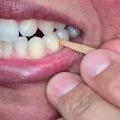Inflamed gums
(gingivitis/parodontitis)
How do inflamed gums develop?
If plaque is not removed daily along the gum line and between the teeth, the gums become irritated. After about 48 hours, the gums already become inflamed.
Gingivitis (image 2)
Insufficient oral hygiene causes the gums to become inflamed. The initial stage of inflamed gums is called gingivitis. How do you notice this?
- Gums are red in color and may be flabby and/or swollen.
- Gums bleed easily when brushing or using sticks/brushes/floss.
Parodontitis (image 3)
If the inflammation spreads further to the deeper tissues and jawbone, we speak of periodontitis. Periodontitis does not always have to cause pain. With a timely diagnosis and proper treatment by a dentist or dental hygienist, the loss of teeth can be prevented.
What are the symptoms of periodontitis?
- The gums no longer close tightly around the teeth.
- The space between the tooth and gums becomes deeper. If this space is deeper than 3 mm then this is called a “pocket”. Because pockets are difficult to clean, plaque can easily remain here and tartar can form.
- The jawbone in which the teeth are attached becomes inflamed and can even disappear due to this inflammation.
- The gums may recede.
- Teeth can lose their support, become loose and even fall out.
- You can also suffer from bad breath (halitosis).
Advanced Parodontitis (afbeelding 4)
In advanced periodontitis:
- A large part of the supporting tissue (including the jawbone) has disappeared.
- The pockets become much deeper than 3 mm. If the gums recede far, the teeth seem to become more and more “longer”.
- The root split at the molars (furcation) may become visible.
- Teeth and molars become looser and looser.
- You often suffer from an unpleasant taste in the mouth and/or bad breath (halitosis).


















